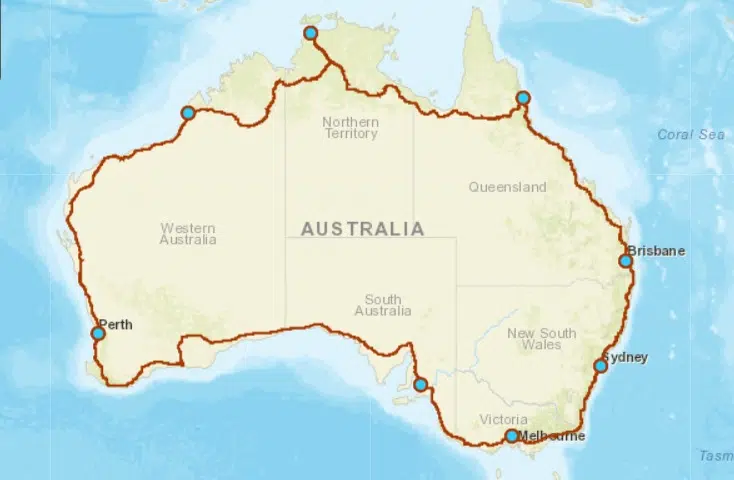
What are the five longest roads in the world?
Most of us will spend most of our lives close to home and work. The occasional trip to visit different shops, or down to the seaside on a sunny day. But there are those brave adventurers who like a challenge and want to grab life by the horns, balls, or whatever it has and forge a path ahead, walked by few others.
The longest journey I’ve ever driven is from Glasgow in Scotland down to Canterbury in England, around 460miles. I managed this in one day and has put me off long distance trips since. But looking at the lists of the longest roads in the world just makes me dizzy thinking about it.
It continues to amaze me at the skill, determination and ingenuity of thousands of people, dozens of countries and the vast sums of money needed to create these epic highways linking together not only countries but continents.
5 – Trans-Canada Highway (7821km/4,860miles)

The Trans-Canada Highway is one of the longest national highways in the world, stretching approximately 7,821 kilometres (4,860 miles) across Canada, from St. John’s, Newfoundland, in the east to Victoria, British Columbia, in the west. It connects all ten provinces, making it a crucial artery for both domestic travel and trade. The highway traverses Canada’s diverse landscapes, including vast forests, rolling prairies, rugged mountains, and coastal regions, providing travellers with a unique opportunity to experience the country’s natural beauty.
Completed in 1971, the Trans-Canada Highway is an engineering feat, passing through some of the most remote and challenging terrains in North America, including the towering Rocky Mountains. It links major cities such as Toronto, Montreal, Calgary, and Vancouver, as well as countless smaller towns and rural areas, supporting the movement of goods, people, and services across Canada’s vast landmass.
As a symbol of national unity, the highway also serves as a popular route for road trips, attracting both Canadian and international travellers seeking to explore the country’s varied geography. Its length, importance for trade, and role in connecting the country’s regions make the Trans-Canada Highway one of the most significant road networks in the world.
4 – WE-WC Highway (8445km/5,250miles)

The Western Europe to Western China (WE-WC) Highway is one of the longest road routes in the world, spanning approximately 8,445 kilometres (5,250 miles) and connecting Europe with Asia. This vast transcontinental highway begins in St. Petersburg, Russia, and stretches all the way to Lianyungang in China, passing through several countries, including Kazakhstan. It serves as a vital link between the two continents, facilitating trade, commerce, and travel between Europe and the rapidly growing economies of Asia.
The highway is part of a larger initiative known as the New Silk Road, which aims to revitalize ancient trade routes by modernizing infrastructure across Eurasia. The WE-WC Highway passes through a wide range of environments, including urban centers, vast steppes, deserts, and mountains. Its strategic importance is heightened by its ability to significantly reduce travel time for transporting goods between Europe and China, providing an alternative to sea and rail transport.
The construction of this highway required overcoming significant engineering challenges, particularly in remote areas with harsh climates. Today, the WE-WC Highway is not only an essential route for trade but also offers travellers an opportunity to journey through the heart of Eurasia, experiencing diverse cultures, landscapes, and historical sites along the way.
3 – Trans-Siberian Highway (11,000km/6,800miles)

The Trans-Siberian Highway is one of the longest roads in the world, stretching approximately 11,000 kilometres (6,800 miles) across the vast expanse of Russia. This extensive road network connects St. Petersburg in the west to Vladivostok in the east, traversing diverse landscapes, including forests, mountains, rivers, and the remote wilderness of Siberia. It serves as a vital link between Europe and Asia, making it one of the most significant transcontinental routes in the world.
The highway crosses eight time zones and passes through major Russian cities such as Moscow, Ufa, and Irkutsk, as well as countless smaller towns and rural areas. It offers travelers a unique glimpse into Russia’s vast geography, from the bustling urban centers in the European part of the country to the isolated, frozen stretches of Siberia.
The road’s construction was an engineering feat, given the challenges of building through harsh climates, especially in Siberia, where winters are long and severe. Despite these challenges, the Trans-Siberian Highway has become a crucial route for both domestic and international transport, supporting trade and tourism. Its length and the wide range of environments it passes through make it one of the most iconic and adventurous roads in the world.
2 – Highway 1 – Australia (14,500km/9,000miles)

Australia’s Highway 1 is one of the longest roads in the world, spanning approximately 14,500 kilometres (9,000 miles) and forming a loop around the entire continent. This national highway connects all of Australia’s major coastal cities, including Sydney, Melbourne, Brisbane, Perth, and Darwin, making it an essential artery for both trade and tourism. Highway 1 not only links the populous eastern seaboard but also traverses remote and rugged regions in the north and west, providing access to Australia’s diverse landscapes.
The road passes through tropical rainforests, deserts, coastal areas, and vast outback regions, offering travellers a chance to experience the country’s natural beauty and changing environments. Due to its extensive reach, Highway 1 is a popular route for road trips, attracting both locals and international visitors who seek to explore the continent’s unique geography and iconic landmarks like the Great Barrier Reef and the Nullarbor Plain.
Highway 1 is also crucial for the Australian economy, facilitating the movement of goods and services across vast distances. Its importance, combined with its status as the longest national highway in the world, makes Highway 1 a remarkable feature of Australia’s infrastructure and a global landmark in road networks.
1 – Pan American Highway (30,000km/19,000miles)

The Pan-American Highway is the longest road network in the world, spanning approximately 30,000 kilometres (19,000 miles) and connecting North, Central, and South America. It stretches from Prudhoe Bay, Alaska, in the northern United States, to Ushuaia, Argentina, at the southern tip of South America, passing through 14 countries along the way. The route traverses a diverse range of landscapes, from the icy Alaskan tundra to tropical rainforests in Central America and the arid deserts of Peru.
This vast network of roads is an engineering marvel, but it’s not entirely continuous due to the Darien Gap, a 160-kilometer (100-mile) stretch of dense jungle and swampland between Panama and Colombia that is impassable by road. Despite this gap, the Pan-American Highway serves as a crucial route for trade and travel, linking major cities and facilitating cultural and economic exchanges between the Americas.
The highway offers adventurers a unique opportunity to experience the varied cultures, ecosystems, and terrains of the Western Hemisphere, making it a popular route for road trips and long-distance cycling. Its immense length and geographical diversity make the Pan-American Highway a true global landmark and one of the most iconic roads in the world.
